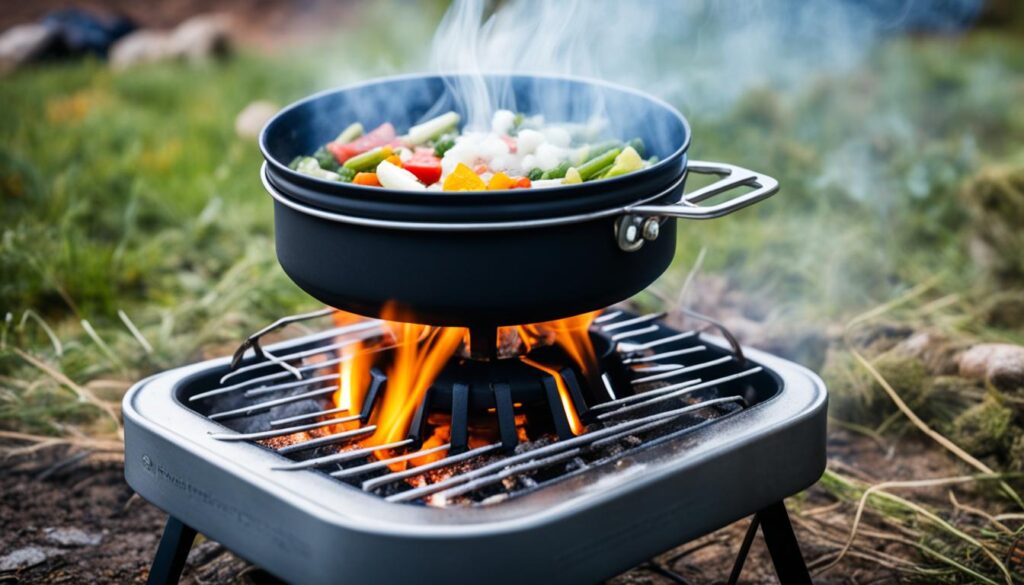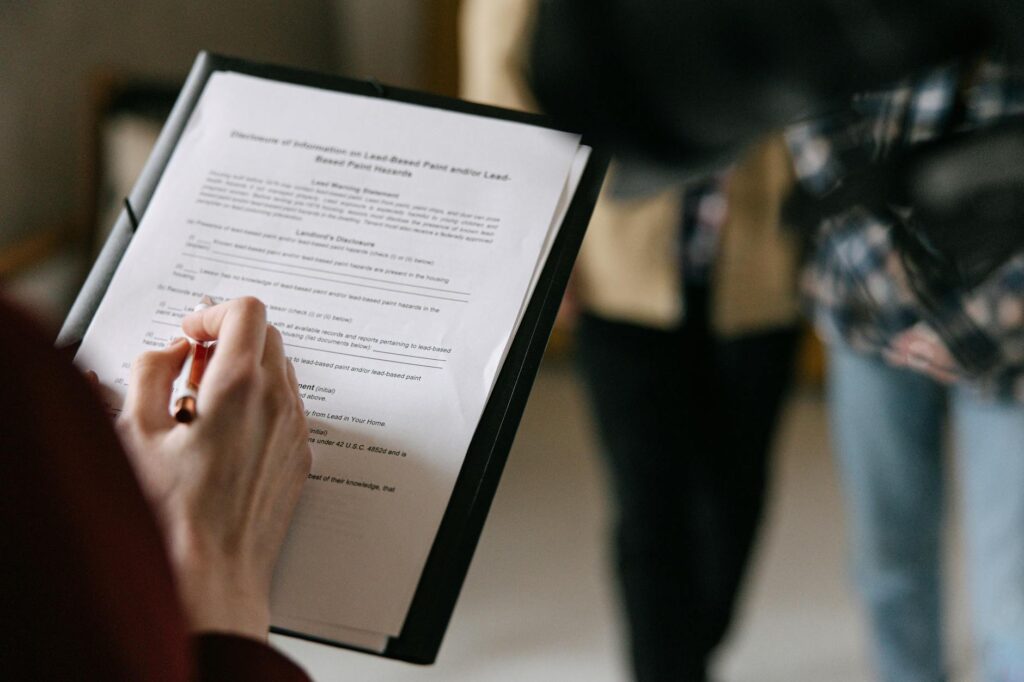Welcome to the world of outdoor adventures and the joy of spending time in the great outdoors! A reliable camping stove is an essential tool for cooking warm meals while camping, hiking, or picnicking. In this comprehensive guide, I will explore everything you need to know about using a camping stove, including safety tips, fuel options, and proper setup and maintenance instructions.
Key Takeaways:
- Learn how to use a camping stove safely and efficiently.
- Explore different types of camping stoves and choose the one that suits your needs.
- Understand the various fuel options available for camping stoves.
- Follow essential safety precautions when using a camping stove.
- Properly set up and light your camping stove for optimal performance.
Contents
- 1 Choosing the Right Camping Stove for Your Needs
- 2 Selecting the Right Fuel for Your Camping Stove
- 3 Essential Safety Precautions for Using a Camping Stove
- 4 Properly Setting Up Your Camping Stove
- 5 Lighting Your Camping Stove
- 6 Cooking on Your Camping Stove
- 7 Properly Clean and Store Your Camping Stove
- 8 FAQ
- 9 Source Links
Choosing the Right Camping Stove for Your Needs
When it comes to selecting a camping stove, it’s essential to consider your unique needs and preferences. Factors such as your camping style, group size, and cooking requirements should influence your decision. With various types of camping stoves available, including canister stoves, liquid fuel stoves, wood-bu rn ing stoves, and multi-fuel stoves, you have plenty of options to choose from. Let’s explore each type in detail:
Canister Stoves
Canister stoves are lightweight and compact, making them ideal for backpackers and campers who prioritize portability. These stoves use pre-filled canisters of propane or butane gas. They are easy to set up, with a simple push-and-twist connection to the fuel canister.
Liquid Fuel Stoves
Liquid fuel stoves are versatile and reliable options for outdoor cooking. They typically run on white gas, also known as camp fuel or naphtha. These stoves offer excellent performance in different weather conditions, including cold temperatures. Liquid fuel stoves require priming, but they provide a high heat output and longer burn times.
Wood-burning Stoves
For campers seeking a more traditional and environmentally-friendly cooking experience, wood-burning stoves are an excellent choice. These stoves use natural fuels such as twigs, branches, or wood pellets, eliminating the need to carry a separate fuel source. Wood-burning stoves create a unique connection to nature and offer a rustic ambiance.
Multi-fuel Stoves
If you want maximum versatility in your camping stove, a multi-fuel stove is the way to go. These stoves can run on multiple fuel types, such as gasoline, kerosene, diesel, or even jet fuel. They are perfect for international travel or areas where specific fuel types may be challenging to find.
By considering your camping needs, you can choose the camping stove that suits you best. Whether you prioritize portability, dependability, environmental sustainability, or all of the above, there’s a camping stove out there to enhance your outdoor cooking experience.
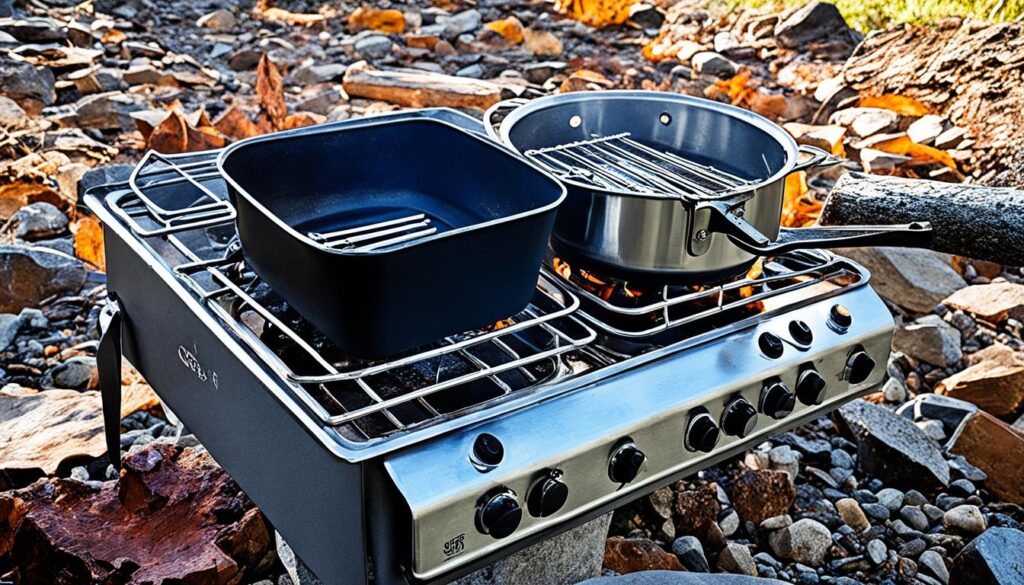
Selecting the Right Fuel for Your Camping Stove
Choosing the right fuel for your camping stove is essential to ensure optimal performance and efficient cooking during your outdoor adventures. Different types of camping stoves require specific fuels that offer unique benefits and considerations. Let’s explore some of the most common fuel options:
Propane
Propane is a popular choice for camping stoves due to its efficiency and convenience. It offers a consistent heat output and is easy to use, making it ideal for beginners or those who prioritize simplicity. Propane can be easily found in portable canisters, making it readily available for your outdoor cooking needs.
Butane
Butane is another excellent option for camping stoves, especially if you need a high heat output for fast and efficient cooking. It burns cleanly and provides a stable flame even in colder temperatures. However, it’s worth noting that butane may not perform as well at higher altitudes, so consider your camping location and climate conditions before choosing this fuel.
White Gas
If versatility and clean burning are important to you, white gas is a reliable choice. White gas, often referred to as camp fuel or Coleman fuel, can be used in various camping stoves and multi-fuel stoves. It offers consistent performance in different weather conditions, making it a popular option for outdoor enthusiasts who prioritize adaptability and efficiency.
Kerosene
Kerosene is a fuel that performs well in cold weather, making it suitable for camping in colder climates. It provides a stable and reliable flame, even in sub-zero temperatures. If you plan to camp in chilly conditions, kerosene may be the fuel of choice for your camping stove.
Wood
For those who want to embrace a more traditional and eco-friendly approach, wood-burning stoves are an excellent option. Wood is a sustainable and readily available fuel source in most outdoor environments. It adds a rustic charm to your camping experience and allows you to connect with nature by gathering wood for cooking. However, it’s important to note that wood-burning stoves require proper setup and maintenance to ensure safety and efficient burning.
| Fuel | Benefits | Considerations |
|---|---|---|
| Propane | Efficient and easy to use | Requires portable canisters |
| Butane | High heat output, clean burning | May not perform well at high altitudes |
| White Gas | Versatile, burns cleanly | Requires a specific fuel source |
| Kerosene | Performs well in cold weather | May have an odor and require proper storage |
| Wood | Sustainable, readily available | Requires proper setup and maintenance |
Essential Safety Precautions for Using a Camping Stove
Safety should always be a top priority when using a camping stove. By following essential safety precautions, you can ensure a risk-free and enjoyable outdoor cooking experience. Take the necessary steps to protect yourself, others, and the environment when operating your camping stove.
Read the Instructions
Before using your camping stove, thoroughly read the manufacturer’s instructions to familiarize yourself with its specific features and operating procedures. This will help you understand how to safely use and maintain your stove.
Use in a Well-Ventilated Area
Ensure that you use your camping stove in a well-ventilated area to prevent the buildup of potentially harmful gases. Outdoor settings with plenty of fresh air circulation are ideal for safe stove operation.
Keep Flammable Materials Away
Always maintain a safe distance between your camping stove and flammable materials such as tents, trees, dry grass, and other combustible items. This helps prevent accidental fires and ensures your safety while cooking.
Place on a Stable Surface
Set up your camping stove on a stable and level surface to prevent it from tipping over during use. Uneven terrain can pose a safety hazard, potentially leading to burns or other accidents.
Protect from Wind and Rain
If possible, position your camping stove in an area sheltered from strong winds and rain. Sudden gusts of wind can blow out the flame, and exposure to rain may affect the stove’s performance. Take precautions to maintain a steady flame and ensure efficient cooking.
Supervise at All Times
Never leave your camping stove unattended while it is in use. Supervision is crucial to ensure that the flame remains stable and does not pose a danger to yourself or others. Stay nearby and keep a watchful eye on the stove at all times.
Use Heat-Resistant Gloves
When handling your camping stove, especially when adjusting the flame or moving hot cookware, use heat-resistant gloves. These gloves provide protection against burns and allow for safer handling of hot objects.
Practice Safe Fuel Handling
Handle fuel for your camping stove with care. Follow the manufacturer’s recommendations for refueling, ensuring that no fuel spills occur. Store fuel containers away from the stove and in a well-ventilated area to prevent accidents and the risk of ignition.
Extinguish the Flame Properly
After you have finished cooking, extinguish the flame of your camping stove properly. Close the fuel valve and allow the stove to cool down before storing it. This ensures that there are no lingering flames or hazards.
Carry a Fire Extinguisher
Always have a fire extinguisher nearby when using a camping stove. In the event of an emergency or accidental fire, a fire extinguisher can help prevent further damage and ensure everyone’s safety.
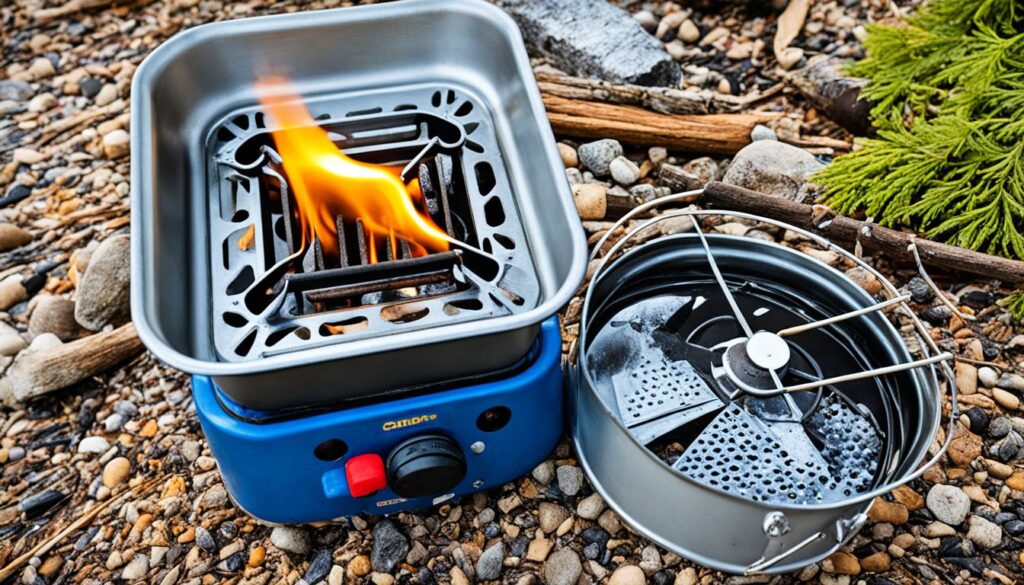
Incorporating these camping stove safety precautions into your outdoor cooking routine will give you peace of mind and help prevent accidents or injuries. By prioritizing safety, you can fully enjoy the convenience and comfort of cooking meals while camping or exploring the great outdoors.
Properly Setting Up Your Camping Stove
Setting up your camping stove correctly is essential for safe and efficient cooking. Follow these step-by-step instructions to ensure a smooth setup process:
- Choose a level surface: Find a stable and flat surface to set up your camping stove. This will help prevent any accidents or spills during cooking.
- Clear the area: Remove any flammable objects or debris from the surrounding area. It’s crucial to have a clear space to minimize the risk of fire.
- Assemble the stove: Refer to the manufacturer’s instructions and assemble the camping stove according to the provided guidelines. Ensure that all parts and components are securely connected.
- Attach the fuel canister or connect the hoses: Depending on the type of camping stove you have, either attach the fuel canister securely or connect the hoses to the appropriate fuel source. Double-check for any potential leaks or loose connections.
- Check for fuel leaks: Before igniting the stove, perform a thorough check for any fuel leaks. Apply a small amount of soapy water to the connections and look for bubbles. If bubbles appear, there may be a leak, and you should fix it before proceeding.
- Open the control valves: Ensure that all control valves on your camping stove are in the closed position before opening them. This will help regulate the fuel flow during cooking.
- Ignite the stove: Based on the specific ignition method of your camping stove, carefully light the burner(s). Follow the manufacturer’s instructions to avoid any accidents.
- Verify the flame: Once the stove is lit, verify that the flame is steady and blue. A blue flame indicates complete combustion and efficient burning of the fuel.
- Test the stability: Gently apply pressure to different areas of the camping stove to check for stability. It should remain sturdy and upright during cooking to prevent any spills or mishaps.
- Ensure proper ventilation: Adequate ventilation is crucial when using a camping stove. Make sure there is enough airflow around the stove to maintain proper combustion and prevent the accumulation of harmful gases.
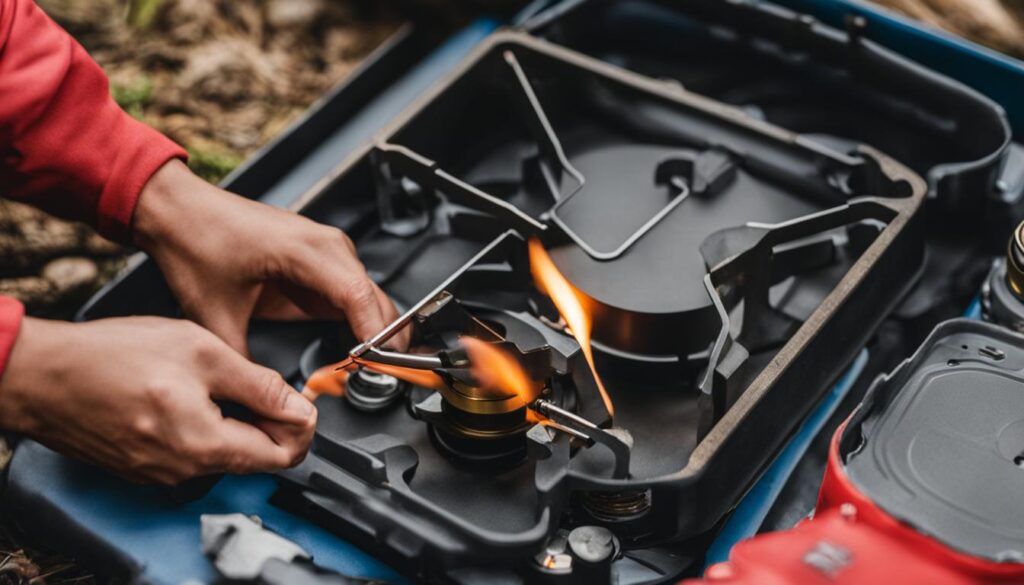
Properly setting up your camping stove is essential to ensure a safe and enjoyable outdoor cooking experience. Following these steps will help you get your stove ready for delicious meals in the wilderness.
Lighting Your Camping Stove
Before you can start cooking on your camping stove, you need to know how to properly light it. Follow these steps to ensure a safe and successful ignition:
- Check the fuel level: Before lighting your camping stove, make sure you have enough fuel. Running out of fuel in the middle of cooking can be frustrating, so it’s essential to check the level beforehand.
- Open the fuel valve: Locate the fuel valve on your camping stove and open it. This will allow the fuel to flow to the burner and prepare it for ignition.
- Ignite the stove: Use a match or a lighter to ignite the stove. Make sure to follow the manufacturer’s instructions for lighting to ensure a safe ignition. Keep your face and hands at a safe distance from the stove while lighting it.
- Adjust the flame: Once the stove is lit, adjust the flame to a steady blue one. This indicates that the stove is burning efficiently and producing the desired level of heat. Adjust the flame control knob to increase or decrease the intensity of the flame as needed.
- Test the stability: To ensure the stove is securely set up, apply slight pressure to it from different angles. The stove should remain stable and not tip over easily. If it wobbles or feels unstable, adjust the legs or base until it is secure.
Properly lighting your camping stove is crucial for safe and effective cooking. By following these steps, you’ll be ready to prepare delicious meals in the great outdoors!
Cooking on Your Camping Stove
Once your camping stove is lit, you’re ready to start cooking! Whether it’s breakfast, lunch, dinner, or snacks, the possibilities are endless. Prepare your ingredients, use heat-resistant cookware, follow recipes or experiment with your own creations, and adjust the flame as needed for the desired cooking temperature. With your camping stove, you can enjoy delicious meals in the great outdoors.
Outdoor Cooking Tips
- Plan your meals: Before heading out, plan your camping stove recipes and make a checklist of the ingredients you will need.
- Pack the essentials: Bring essential cooking utensils such as a spatula, tongs, pots, pans, and a cutting board.
- Keep it simple: Opt for recipes that are easy to prepare and require minimal ingredients. One-pot meals and foil packet cooking are great options.
- Prep ahead: Pre-cut and marinate ingredients at home to save time and make cooking at the campsite easier.
- Use local ingredients: Take advantage of the local produce and flavors available near your campsite to enhance your camping stove cooking.
- Be mindful of portion sizes: Consider the number of people you’re cooking for and adjust the recipe accordingly to minimize food waste.
- Experiment with flavors: Spice up your meals by bringing a selection of herbs, spices, and sauces to add extra flavor to your dishes.
Camping Stove Recipes
Here are a few camping stove recipes to inspire your outdoor cooking adventures:
- Breakfast Skillet: Start your day with a delicious campfire breakfast skillet. Cook diced potatoes, onions, bell peppers, and breakfast sausage in a cast iron skillet. Crack eggs on top, cover with a lid, and let them cook until the yolks are set. Serve with a sprinkle of shredded cheese.
- Grilled Chicken Fajitas: Marinate chicken breast strips with lime juice, garlic, and Mexican spices. Grill the chicken on your camping stove and sauté sliced bell peppers and onions in a separate pan. Serve with warm tortillas, salsa, and guacamole.
- One-Pot Pasta: Cook your favorite pasta in a pot with diced tomatoes, onions, garlic, and Italian herbs. Add water or broth as needed and let it simmer until the pasta is cooked and the sauce is thickened. Garnish with fresh basil and grated Parmesan cheese.
- Campfire Nachos: Layer tortilla chips, cooked ground beef or shredded chicken, black beans, diced tomatoes, sliced jalapeños, and shredded cheese in a cast iron skillet. Place the skillet on your camping stove and let the cheese melt. Serve with sour cream and guacamole.
Feel free to customize these recipes to suit your taste preferences and the ingredients you have on hand. Camping stove cooking is all about creativity and enjoying the flavors of nature!
Properly Clean and Store Your Camping Stove
After using your camping stove, it’s crucial to prioritize proper cleaning and storage to maintain its longevity and performance. Following these simple steps will ensure that your camping stove is ready for many more outdoor adventures to come.
First, allow the stove to cool down completely before starting the cleaning process. Once cooled, disassemble the stove, removing any detachable parts such as burners, grates, and knobs. This will make it easier to clean each component thoroughly.
Next, wipe off any food residues or spills from the stove’s surface using a damp cloth. For stubborn stains or grease, use a mild detergent and a sponge to gently scrub the affected areas. Avoid using harsh or abrasive chemicals that could damage the stove’s finish.
Once all the parts are clean, rinse them thoroughly with warm water to remove any detergent residue. Ensure that all parts are completely dry before reassembling the stove. Moisture can lead to rust or corrosion, impacting the performance and safety of your camping stove.
Finally, store your camping stove in a dry and secure location. Keep it protected from moisture, extreme temperatures, and potential damage from other camping gear. Consider using a dedicated storage bag or case to keep all the components together and organized.
By following these cleaning and storage practices, you’ll extend the lifespan of your camping stove, ensuring it remains in excellent condition for future outdoor adventures. Proper maintenance and care will not only enhance the stove’s performance but also provide you with peace of mind during your camping trips.
FAQ
How do I choose the right camping stove for my needs?
Consider factors such as your camping style, group size, and cooking requirements. There are different types of camping stoves available, including canister stoves, liquid fuel stoves, wood-bu rn ing stoves, and multi-fuel stoves. Canister stoves are lightweight and ideal for backpacking, while liquid fuel stoves are versatile and reliable. Wood-bu rn ing stoves provide a unique connection to nature, and multi-fuel stoves offer maximum versatility.
What type of fuel should I use for my camping stove?
Each type of camping stove requires specific fuels. Propane is efficient and easy to use, while butane offers high heat output. White gas is versatile and burns cleanly, and kerosene performs well in cold weather. Wood is a sustainable and readily available fuel for wood-bu rn ing stoves. Consider availability, ease of use, climate conditions, and environmental impact when choosing your camping stove fuel.
How can I ensure safety when using a camping stove?
Follow essential safety precautions such as reading the instructions, using the stove in a well-ventilated area, keeping flammable materials away, placing the stove on a stable surface, protecting it from wind and rain, supervising it at all times, using heat-resistant gloves, practicing safe fuel handling, extinguishing the flame properly, and carrying a fire extinguisher. These precautions will ensure a risk-free and enjoyable outdoor cooking experience.
What are the steps to properly set up a camping stove?
Choose a level surface, clear the area of flammable objects, assemble the stove according to the manufacturer’s instructions, attach the fuel canister or connect the hoses, check for fuel leaks, open the control valves, ignite the stove, verify the flame, test the stability, and ensure proper ventilation. Following these steps will ensure a smooth setup process.
How do I properly light a camping stove?
Check the fuel level and ensure you have enough fuel. Open the fuel valve, light the stove using a match or lighter, adjust the flame to a steady blue one, and test the stability by applying slight pressure. Properly lighting your camping stove is crucial for safe and effective cooking in the outdoors.
What are some tips for cooking on a camping stove?
Prepare your ingredients, use heat-resistant cookware, follow recipes or experiment with your own creations, and adjust the flame as needed for the desired cooking temperature. With your camping stove, you can enjoy delicious meals in the great outdoors.
How should I clean and store my camping stove?
Allow the stove to cool down, disassemble it, wipe off any food residues, use mild detergent and a sponge for stubborn stains, rinse and dry all parts thoroughly, and store them in a dry and secure location. Proper maintenance and storage will ensure the longevity of your camping stove for future outdoor adventures.
